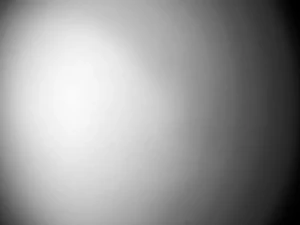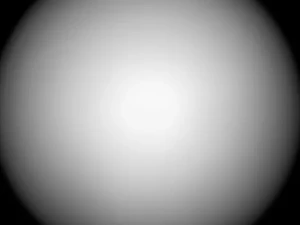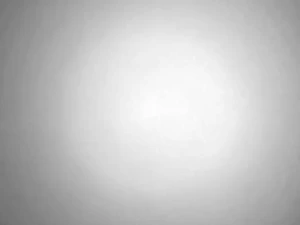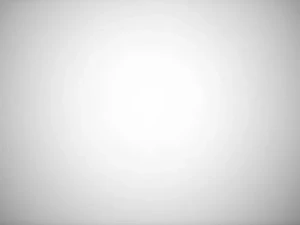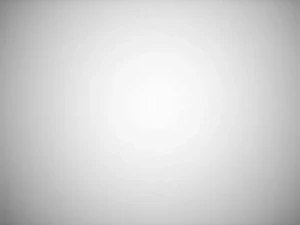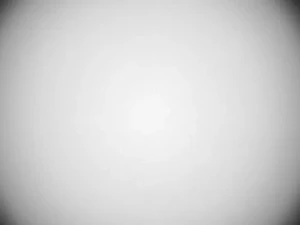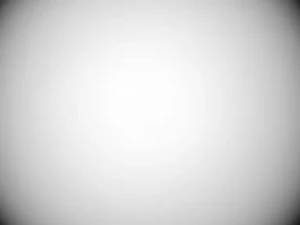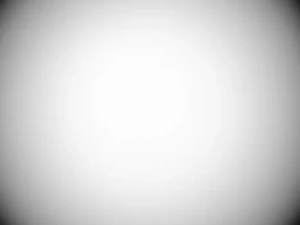Adaptation of lenses for smaller formats, with correspondingly smaller image circles, involves advantages and trade-offs: adapted lenses are typically more varied, plentiful, cheaper, smaller and higher resolving – but inevitable compatibility issues range from trivial to insuperable.
The GFX 44x33mm sensor lies between the classic 35mm ‘full-frame’ and 645 medium formats. As well as Fujifilm’s superb native lenses, GFX users have the choice of cropping for the sweet spot of larger lenses – the well-trodden adaptation path for Micro Four-Thirds and APS-C users – or, less conventionally (and less obviously a good idea), seeing what happens when you allow the image circle of a 35mm lens to land on the bigger sensor. As it turns out, GFX doesn’t look that big a stretch to many 35mm lenses – as we’ll discuss below.
Setting aside the question of how they perform in Zone C and D (see below), the first step to assessing the suitability of off-piste lenses for the GFX is consideration of their coverage: do they throw a big enough puddle of light to avoid hard black corners and/or soft ‘grey’ vignetting? Since the launch of the GFX series, users worldwide have been asking, and answering, this question. Thanks to the efforts of Christian Schnalzger, information about hundreds of adapted lenses has been compiled in the GFX LENS MASTER LIST – a freely available Google Docs spreadsheet.
Supplementing it, demonstrating the compatibility of many other lenses – including macro, industrial, projection and enlarger lenses drawn from the Delta archive – we here show vignette maps shot at the worst-case scenario of infinity focus, wide open. Many lenses in this situation are vignette free at smaller apertures and/or shorter working distances. Please also note that deal-breaking vignetting visible shooting a white wall is less conspicuous shooting typical subjects. Lenses without hard vignetting can generally be considered to ‘cover the sensor’, even if they have strong, gradual vignetting which to some extent is a property of every lens in that use case – including native Fujfilm GF glass. The viewer is left to judge whether the scale and contour of the darkening is adequate to their purpose. We also consider below the utility of lenses with hard vignetting. But first . . .
Vignette Maps with Adapted Lenses < 50mm
Vignette Maps with Adapted Lenses > 51mm
Reviews
Thumbnails are downscaled image captures (not graphics) of a white wall shot with the lens stopped open, focused at infinity. Vignetting invariably improves at near focus. Soft vignetting also tends to improve as the lens is stopped down, though some of those tested have fixed apertures (noted below). Hard vignetting is usually a symptom of an physical obstruction and doesn’t alter with aperture. The tonal difference between the lightest and darkest values has been consistently maximised to communicate a worst case. In real-world photography, the effect is less noticeable.
Agfa Color-Agolar 60mm f2.8: practically zero vignetting at its fixed f2.8 aperture. Optimised for middle-distance projection of medium-format transparencies.
Canon 300mm f4 L (non-IS first version): some hard vignette in the extreme corners that may be improved by removing the rear baffle. The later IS version hasn’t been tested.
Durst Neonon: The 80mm f5.6 6-element lens covers GFX well – apart from a tell-tale mechanical vignette in the extreme corner. Typical of enlarger lenses, it is sharpest at sub-2m distances.
Fuji 55mm f2: Known for it’s pleasant drawing style and soap-bubble (nisen) bokeh at maximum aperture, this old Fuji 35mm lens is surprisingly comfortable on the newer Fujifilm GFX, covering its sensor completely.
Fujinon EX: The 50mm f2.8 is extremely sharp in Zone A but performance dips in Zones C/D, and hard vigneting is present. However, from 75mm up (including the 90mm, 105mm and 135mm variants), sharpness and coverage are immaculate, earning all Fujinon EX a ‘Gold’ rating at Delta Lenses. Sharpest at sub-2m distances.
Isco Ultra MC: The range comprises f2 prime cine projector lenses that cover GFX almost completely from 75mm. Shorter focal lengths (ie, the 60/2) have varying degrees of vignette.
Jupiter-9 85mm f2: The Russian Sonnar covers GFX perfectly, and only needs be stopped down to improve corner resolution.
Kodak Enlarging Ektar 75mm f4.5: Perfect coverage, and resolution improves stopped down. The Heliar Ektars maintain their performance at long range better than most enlarger lenses and have a very smooth, low-contrast drawing style abetted by circular diaphragms.
Kowa (Beseler) Color Pro: AKA Kowa Computar and Beseler Color Pro (post 1985). Very good sharpness from f5.6-f8 throughout the range, but the 50mm f2.8 has hard vignetting on GFX.
Leitz Focotar: There are several generations of Focotar 50mm. The V1 covers GFX with a smooth, shallow vignette at f4.5 and improves stopped down to f5.6-8 where it is very sharp at near distance, and renders smoothly at all apertures.
Meopta Belar 50mm f4.5: The V3 Belar covers GFX without vignetting even at infinity focus and maximum aperture. However, it is optimised for near-field subjects and resolution begins to tail off entering Zone C. Peak performance in Zone A is f5.6 but corners require F8-11 to sharpen up. The square aperture gives distinctive bokeh rendering.
Nikon 28mm f2.8 AIS: Even illumination across the GFX frame that crashes quite hard into Zone D vignette.
Nikon EL-Nikkor Range: The later N-Series 50mm, 63mm and 80mm lenses are all Gold awarded enlarger lenses. The 105mm is also excellent, scoring a high Silver rating at Delta. The EL N 50/2.8 doesn’t cover GFX well, but the 63mm and longer lenses have no vignetting at all on GFX. Later EL-Nikkors are unusually good at longer distance compared to their competition, making them excellent general-purpose taking lenses.
Palar 40/3.5: Short enlarger lens that only just covers 35mm, with strong vignetting on GFX.
Olympus 35mm Shift MC f2.8: As expected, the image circle is large enough to cover GFX plus c.5mm additional shift. Vignetting is completely clear on this format by f5.6. Sharpness is very good from f8-f11 – better in this sample than the Pentax 645 A and FA 35/3.5 and the Mamiya equivalents. Among adaptable lenses at this focal length it is only bettered by the Zeiss Distagon PC 35mm and Contax 645 35mm. However, the Tamron 35/1.8 VC is sharper in Zones A-C at comparable apertures – but it too requires f8-f11 to deliver useable GFX corners.
Samyang/Rokinon 85mm f1.2 XP: Strong vignette at f1.2 and infinity focus, but Zone C/D resolution is very good, even at this aperture – and the darkening is correctable. Vignetting is much improved at shorter distances and smaller apertures, becoming almost perfectly illuminated at f5.6, but fully useable at f2.8. Compared to the Sigma 85mm Art DG, the Samyang renders more smoothly and is sharper at wide apertures in the outer frame. However, the Sigma improves hugely in Zones A-B from f2 and resolves slightly better overall at f5.6. The Samyang 85 XP has strong pincushion distortion in Zone D, whereas the Sigma 85 DG (unlike the DN) is well corrected for geometry throughout the GFX-visible frame.
Samyang/Rokinon 135mm f2: Soft vignette only in extreme corners. Covers GFX almost as well as the Fujifilm 110mm f2, and is almost as sharp across the frame.
Schneider Componon: the 50/4 has noticeable soft vignetting on GFX but the later V4 is bitingly sharp at all distances.
Schneider Apo-Componon 60/4: A Gold-awarded enlarger lens suited for just about every purpose, although corners are relatively soft at long distance. Coverage of GFX in terms of illumination is flawless.
Sigma 14-24mm f2.8 DG Art: The lens here tested is the DSLR version rather than the later DN (for mirrorless) lens. As standard, it is vignette-free on GFX from 20-24mm, in which range it has perfect geometry at 20mm and subtle pincushion at 24mm – which distinguishes it from the Canon 16-35mm L III (squirrely in Zone D) and typical adapted 35mm optics which are rarely pin-sharp outside their usual range of coverage. By f4, the 14-24mm Art renders corners comparable to native GF glass – by which I mean that you need to stop down to f8 to achieve critical sharpness, but have useable resolution at wider apertures. Its sweet spot is 16-21mm; above that the DG version (unlike the DN) softens somewhat, and drifts from ruler-perfect geometry. Below 16mm, it is even sharper, but suffers from barrel distortion. It’s frustrating, then, that at about 19mm – right in its happy place – hard mechanical vignetting appears which becomes more troublesome with zooming out. The cause is the petal hood protecting the vulnerable domed front element. Keen to access that appealing 16-19mm range, I trimmed the plastic external section of the hood and liberated excellent, vignette-free performance from 18-20mm. At 17mm (pictured above) the GFX stubbornly continues to manifest dark corners. The solution is to dig into the metal inner section of the Sigma’s front element housing by another 1-2mm, but I chose not to inflict further grief on my sample: 18mm on GFX gives a very sharp, distortion-free equivalent of a 14mm FOV in 35mm terms. Also, because the optical path is only obstructed in the corners of the frame, I can now back out to 16mm and light the whole sensor with a 16-9 crop and a FOV equivalent to a 12mm full frame lens – truly the GFX equivalent of the Laowa 12mm f2.8 Zero D. Fujifilm’s 20-35mm f4 (combined with its profile) is the killer app for this ideal platform for architectural photographers – in 35mm terms, a 16-28mm zoom covers most of the focal lengths you’ll use in a day’s work, but there are plenty of moments when you’ll reach for something longer – and one or two when you’ll wish you had something wider, or a stop faster. The Sigma 14-24mm may therefore be the only ‘adapted up’ lens that could be considered a necessary component to complete an uncompromised GFX system. Equally, for the cash strapped, the combination of this relatively cheap f2.8 Sigma Art (covering 13-19mm equivalent) with the Fuji 32-64mm f4 (covering 25-50mm) – or even the GF kit lens – is a temptingly cheap line-up if you can live with broaching the gap between 20mm and 24mm. GFX100 shooters have the luxury of shooting at 19mm equivalent and using ‘spare pixels’ to fill the hole by cropping, but on GFX50, the precision-framing benefit of a smoothly zooming 16-28mm equivalent may be more keenly felt. Either way, this lens is suprisingly useful, and by a clear margin the sharpest adapted 35mm wide angle lens across the frame – including all the shift lenses that necessarily have appropriately large image circles. In fact, in my system, I have re-adapted the DG 14-24mm to Panasonic L mount for use as a 18-24mm tilt/shift lens. Compared to the Canon 24mm TS-E II, it doesn’t have the full range of shift movements, but it’s a fraction sharper at most apertures up to around 7mm of shift and 8° of tilt. Very highly recommended.
Sigma 24-35mm f2 DG HSM: Harder vignetting at 24mm seems to be mechanical rather than optical. Transmissivity decreases as focal length increases.
Sigma 28mm Art f1.4 DG HSM: The HSM Art Lenses have progressively larger image circles from 20mm to 50mm, with a similar pattern of strong illumunation quickly hitting a vignetting boundary. The 28mm f1.4 is therefore more useable than the 24mm f1.4, but not as versatile as the 35mm f1.4.
Sigma 35mm Art f1.4 DG HSM: Vignetting is of the ‘hard boundary’ type: clearing 90% of the frame by f2.8, but retaining dark corners. Better overall than the Sigma 24-35/2.
Sigma 50mm Art f1.4 DG HSM: Negligible vignetting and excellent performance wide open.
Sigma 85mm Art f1.4 DG HSM: Very sharp, but notable vignetting (worse than the Sigma 50mm f1.4)
Steinheil Cassarit 50mm f3.5: This surprising triplet has an unreasonably large image circle but is quite soft across the frame unless well stopped down. The triangular aperture creates unusual bokeh.
Tamron SP: Soft vignette is clearly present at maximum aperture with both the 35mm and 45mm f1.8 VC primes. However, they improve significantly when stopped down, and by f8 outperform the Sigma Art f1.4 equivalents and resolve serviceably right into the GFX corners. The superior Tamron SP f1.4 sadly has a smaller image circle that fails to cover GFX.
Tominon E36: Available in several focal lengths and branding (including some simply marked ‘E36’). Gold awarded for their superb resolution, sadly the 51/4 fails to cover GFX effectively.
Recommendations
There are no technical advantages to using adapted lenses on the GFX. Native Fujifilm GF lenses have the requirements of studio and architectural photographers covered, and have the additional benefit of lens profiling. If you need critically sharp corners, minimal aberration and maximum resolution, pay for the proper kit.
What is left to recommend, therefore, is a shortlist of lenses that combine adequate performance with distinctive rendering – particularly among the faster lenses that complement Fujifilm’s excellent (but slower) offerings. I have divided them into Gold and Silver categories: Gold-awarded lenses combine technical prowess and aesthetic quality; Silver-awarded lenses are flawed, but interesting.
GOLD:
Sigma 14-24mm f2.8 DG Art (without hood mod, only 20-24mm. F5.6 required for useable corners)
Samyang 135mm f2 (No caveats. Very similar to Fujifilm GF 110/2)
Tamron SP 35mm f1.8 VC (Zone D requires at least f8)
Tamron SP 45mm f1.8 VC (Zone D requires at least f8)
Fujinon EX 75mm f4.5 (not sharp enough until f8)
Nikon EL 63mm f2.8 (sharp enough at f5.6: excellent from macro to landscape distances)
Isco UltraStar HD* 77.5mm f1.8 (F1.8 only – soft corners. Smooth bokeh ne plus ultra. Renders like f1.2)
Sigma 85mm f1.4 DG Art (No caveats)
SILVER
Olympus 35mm f2.8 Shift (only useable at f11, where adequate)
Nikon 28mm PC (only useable at f11, where just adequate)
Schneider Super Angulon 28mm PC (slightly sharper than Nikon 28mm PC, but CA and geometric distortion)
Isco 60/2 (strong bokeh swirl and edge aberration but smooth bokeh and vivid colour)
Sigma 35mm f1.4 Art (at a disadvantage to the Tamron SP 35mm)
Sigma 50mm f1.4 Art (at a disadvantage to the Tamron SP 45mm)
A Brief History of Lens Adaptation
Lens adaptation was the ground zero of this site. In the 1990s, photographers were more generally locked into a mentality of brand loyalty – and that made practical sense when the only real choices for 35mm shooters was Canon or Nikon – each of whom had a wide ecosystem of old and new native lenses, and both of which were well serviced by distinctly second-tier, third-party makers such as Sigma and Tamron.
However, there came a moment around the turn of the millennium when a new generation of digital cameras oustripped the ability of most lenses to resolve them. In desperation, a generation of photographers started to cast the net wider than the inadequate factory offerings. This was a rather a Canon-specific phenomenon. Canon shooters were gifted a more flexible (shorter and wider) flange specification, and so were able to mount Olympus, Leica and Contax/Zeiss optics – some of which proved to be more effective than the Canon equivalents.
In the early noughties, the mission was more about satisfying the sensor than generating an ‘alternative look’. However, it also dawned on us that adaptation of larger-format lenses would opened up an interesting arena of tilt/shift lenses – something that many of those switching from medium and large format film found restrictive about the ‘new’ portable cameras. Photographers became more ‘image circle conscious’: realising that any lens that threw an appropriately-sized light puddle was fair game. Please see below for details.
By the early teens, lens design had caught up. More than anything else, the advent of Micro Four-Thirds demonstrated that very high resolution lenses could be produced quite inexpensively. And without any delay at all, photographers realised that just about any lens could be used with the little new sensor. Suddenly there was a plethora of shift adaptors, manual and auto-focus adaptors, image circle-reducing ‘speedbooster’ adaptors – adopted and adopted by a generation of photographers to whom brand loyalty meant little. All at once, Sony happened. Then the mirrorless revolution. An unintended bonus of the reduction in FFD meant that now almost any modern camera can use almost any old glass in any focal length. Manufacturers released legacy adaptors. We now live in a state of alt-lens paradise.
But there were further suprises in store. When Fujifilm launched the GFX in 2018, there were very few (albeit excellent) lenses for the new GF mount which, having a 27mm flange distance, and sitting in front of a cut-down medium format sensor (44x33mm), swiftly proved to be an ideal platform for adaptation of old-school medium format lenses. Most vintage 645 and 6×6 lenses don’t have critically sharp corners. The 0.79 crop of the GFX was therefore advantageous. However, most medium format lenses are somewhat ‘lazy’, in that they weren’t optimised for high magnification or resolution. Cheap vintage Mamiya and Pentax MF lenses certainly have the look, but the GFX100 made cruel demands with its 3.67 micron sensor, and (as with micro 4/3) adapting down always leaves users short of shorter focal lengths.
In retrospect, its surprising that no-one launched a medium-format speedbooster. Instead, users first turned to 35mm shift lenses which by now were commonly understand to have large image circles – effectively medium format lenses in disguise. But it had also been (less widely) known that lenses like the Nikon 14-24mm f2.8 G achieved their excellent ‘corner’ (Zone C) performance as a consquence of oversized image circles. “What else have we been missing?” wondered GFX users, eyeing the potential of a sudden influx of wider-than-expected lenses adaptable to the GFX’s short FFD. As it turned out, Sigma’s ‘Art’ and Tamron’s ‘SP’ lenses – now fully the equal of camera manufacturers offerings (how times change) – were throwing much bigger image circles than the 35mm format was seeing, and in some cases covered the ‘mini-middle format’ GFX with minimal vignetting. And because the smaller lenses were optimised for higher magnification, it was often better to adapt up than down.
Adaptor manufacturers were quick out of the gate this time. I spent two years in the late 1990s perfecting and seeking production partners for the first commercially-available Nikon G > Canon EF adaptor, and it was an uphill struggle. Now, within months, competing products appeared, with varying degrees of electronic smarts and build quality – and a willing and a ready market.
Since 2018, the GFX community has been experimenting with connecting anything even vaguely glazed to their oversized M43s, and it was inevitable that one man would take it upon himself to corral this information. That man was Christian Schnalzger. Chapeau! Follow the link above to see the current version of Christian’s master list. A number of our own tests and comments are found in the list above, and also at our sister site Delta Lenses.
Zones & Circles
It’s helpful to have in mind the image circle diameters required for each format, as follows (somewhat rounded):
– Micro Four-Thirds: 22mm diameter
– APS-C: 30mm diameter
– 35mm: 43.5mm diameter
– GFX: 55mm diameter
– 645 Medium Format: 70mm diameter
For ease of reference, there are advantages to referring to sectors of the image circle in the following nomenclature:
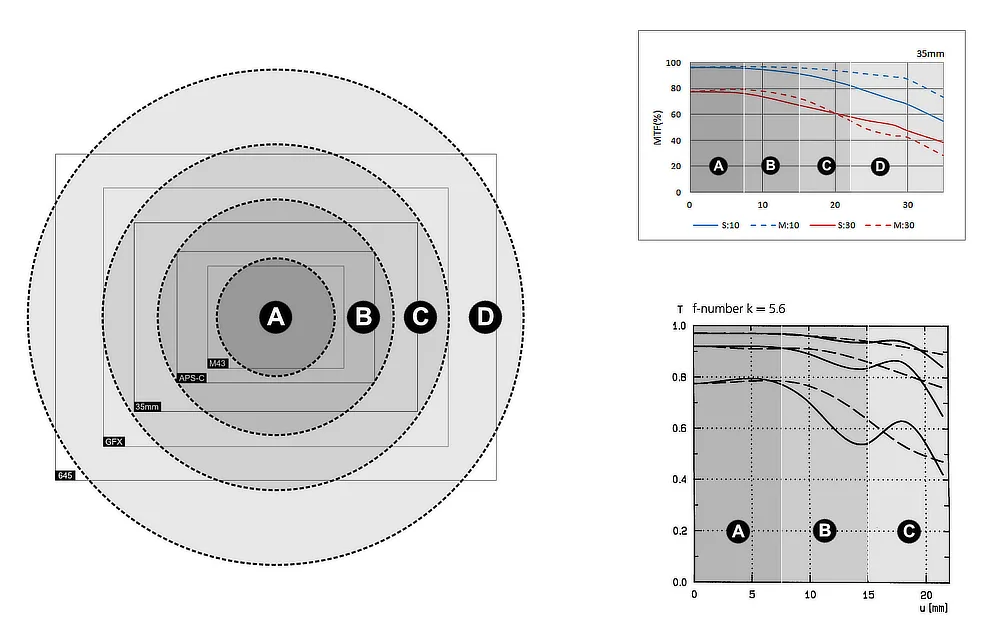
Rather than talking about ‘corner’ or ‘edge’ performance, this method allows us to have a more lens-centric, and realistic, view of the image circle, without getting sidetracked by the rather arbitrary ‘mask’ imposed on the image circle by the sensor’s capture area. Lenses project circles. Letting go of a rectangular mentality allows us to see the adaptation potential of each lens more clearly.
Zone A is an area of 15mm diameter in the centre of the image circle. You’ll note that the M43 format is almost entirely covered by Zone A. Only the short sides lie in the inner section of Zone B. The APS-C format is entirely encompassed by Zones A and B, though the extreme corners are on the brink of Zone C.
Similarly, when we talk about ‘edge’ performance of a 35mm lens, we can see clearly that (as with M43), the long sides are largely covered by Zone B (15-30mm diameter). When inspecting the performance of 35mm optics, most of the differences lie in Zone C (30-43mm diameter), which is effectively a curved strip running down the short sides of the frame.
You’ll also note that by default all 35mm optics cover the full width of the GFX sensor, which measures (perhaps not coincidentally) almost exactly the diameter of the smaller format’s image circle. The squarer proportion of the GFX sensor (like M43) makes more efficient use of projected light. However, to resolve the isolated corners (where (above) we typically see vignetting), a lens is required that extends to Zone D (43-70mm diameter).
Note too that a lens whose image circle is large enough to cover GFX without hard vignetting is suitable for use as a 35mm shift lens with shift movements of at least 4-5mm, and some degree of tilt. For instance, many of the roomier 50mm enlarger lenses are very practical when deployed on tilt adaptors for 35mm sensors, combining close-up optimisation with focal plane control.
Zone D is also where 35mm shift lenses live. To achieve 10mm horizontal shift (in landscape orientation) is more demanding on image circle size than a 10mm vertical shift in the same orientation. Therefore shift lenses for the 35mm format typically have image circles of 70mm diameter – enough to cover 645, and GFX+.
The MTF diagrams (above right) map Zones A-D onto graphs, which typically show the modulated transfer function as a percentage, against distance from the image centre (ie, the radius of the image circle) at a given f-stop. Lenses with 43.5mm image circles designed for the 35mm format usually have relatively poor Zone C performance. Here we see the later Zeiss 21mm f2.8 Distagon also suffering at f5.6 from the ‘Zone B Dip’ identified in the first lens reviewed published on this site. It’s more pronounced at f4. Comparison of the redesigned Pentax 645 D-FA 35mm (above) shows much flatter performance across Zones A-C. Its image circle also degrades in the outer zone (D), but adaptation of this lens to GFX and smaller formats would give ‘corners’ that are much closer to the rendition of the frame centre (Zone A).
Conversely, the reason for the poor performance of almost all adapted lenses relative to native Fuji GF optics can easily be seen. Even though a 35mm optic should reach the short sides of the GFX sensor without significant vignetting, Zone C covers approximately half its frame. In other words, whatever the extreme corners look like on 35mm – that’s the level of performance you’re getting for all the mid-frame of GFX. And whatever lurks in Zone D is unknown until adapted – but if you extrapolate the swan-dive of the MTF curve beyond the graph’s boundary, it’s patently ominous. As we’ve noted, many 35mm lenses unexpectedly have a Zone D – but most vignette soft or hard.
You may be surprised by the superb coverage and performance of enlarger lenses on GFX – some of which, historically, have been adapted to much larger formats than the mini-middle GFX. And while projector lenses in the 50-100mm range tend go soft as soon immediately upon exiting Zone A, you may also be surprised by their strong illumination that fills a GFX (and larger) frame effortlessly and bokehliciously.
Using GFX to Maximise Aspect Ratios
We tend to think of 35mm optics being optimised’ for, or least somehow inseparably associated with, the 3:2 format. However, even if we set rigid rules around not transgressing the boundary of a standard 43.5mm image circle, the GFX allows us to see more of that area, and therefore select a preferred proportion so as to retain the maximum benefit.
For instance, in 35mm crop mode, the GFX 100 delivers a file of 60.8MP (9,552 x 6,368 pixels), sampling a 36x24mm area of its sensor. In 2023, that still places a cropped GFX100 at the top tier of high-res 35mm cameras. Cropping a GFX50 to 36×24 makes little sense compared to a dedicated 35mm sensor camera.
However, shooting without the mask allows us to sample the full image circle and crop in post, choosing our preferred trade-off between field of view and resolution.
For instance, making more efficient use of a (smaller) adapted image with a 4:3 crop nets a 6% increase in resolution (64.4MP), but narrows the horizontal field of view of a 28mm lens to 27mm. The vertical FOV is of course slightly larger.
Opting for a 16:9 crop reduces the megapixel count to 57.5MP but widens the hFOV of a 28mm lens to 26.5mm. Choosing a letterbox 2.35:1 ratio in post reduces to 48.6MP but increases the hFOV of a 28mm lens.
Crucially, however, these figures are not destructive crops of the full frame. Anamorphic squeeze is desirable because it maximises the film area, giving some of the benefits of a larger format. Simply cropping down a 35mm frame gives inferior results. But sampling the full image circle and cropping in post gives none of the drawbacks of anamorphic (the distortion), and all the benefits.
Without stretching the image circle, or stepping outside it and losing image quality, a 16:9 crop upgrades a 28mm capturing an image 9552px wide to a 27mm lens capturing approximately 10450 real pixels. Opening out to a 2.35:1 format, the 28mm becomes a 25mm capturing almost another 1000 pixels. The following chart is supplementary to the one found at Fujifilm explaining the effect of post-production cropping with the full frame and native glass. Here we compare differences in image size and focal length when using lenses adapted from 35mm format, staying strictly within the limits of their image circle. For each aspect ratio, we’ve also calculated the total resolution of the 3:2 sensor required to produce an image of the same size by cropping
| GFX100 Crop | 1:1 | 4:3 | 3:2 | 16:9 | 2.35:1 |
| 66.8MP W:8172px =100MP 3:2 | 64.5MP W: 9287px =72.5MP 3:2 | 60MP W: 9552px | 57.5MP W: 10083px =67.8MP 3:2 | 48.9MP W: 10719px =76.6MP 3:2 | |
| 15mm hFOV= | 17.5mm | 15.4mm | 15mm | 14.2mm | 13.3mm |
| 20mm hFOV= | 23.3mm | 20.5mm | 20mm | 19mm | 17.8mm |
| 24mm hFOV= | 28mm | 24.7mm | 24mm | 22.7mm | 21.4mm |
| 28mm hFOV= | 32.7mm | 28.8mm | 28mm | 26.5mm | 25mm |
| 35mm hFOV= | 40.9mm | 36mm | 35mm | 33.2mm | 31.2mm |
| 50mm hFOV= | 58.4mm | 51.4mm | 50mm | 47.4mm | 44.6mm |
| 100mm hFOV= | 117mm | 103mm | 100mm | 95mm | 89mm |
| 150mm hFOV= | 175mm | 154mm | 150mm | 142mm | 133mm |
| 200mm hFOV= | 234mm | 206mm | 200mm | 189mm | 178mm |
Even in a worst-case scenario of a 35mm lens that has strong vignetting and aberrations outside its native image circle, allowing the GFX100 to focus on the useable part of its projected image will produce results superior to the best single-capture 35mm digital cameras currently available. Staying within these bounds ensures performance consistent with its performance on the smaller format – albeit under the slightly greater scrutiny of a 3.76 micron pixel pitch. Sharp extreme corners on the 35mm format will translate to equally sharp corners on a 16:9 image equivalent to one letterboxed from a 76.6MP sensor, or a square image cropped from the GFX sensor that you would need a 100MP sensor to replicate. All without using native Fujifilm lenses.
Looking at your favourite 35mm format lenses on GFX can be dispiriting – with their hard vignetting and freaky aberrations outside the image circle. In some cases, these can be deployed to effect. But even if you need to produce technically accurate images, a GFX can be the best 35mm mirrorless camera available – with adapted lenses – if you stay within a 43.5mm image circle.
But of course, this rather wastes the potential of this resolution-hungry monster. At long distances, nothing competes with the very high quality of Fujifilm’s native lenses, which are truly some of the finest medium format optics made – needfully so. However, lenses large image circles are plentifully available. A tiny handful of elite vintage medium format glass can even live with the resoution demands of the GFX. But at close range, there is truly an embarrassment of riches among enlarger and industrial optics that combine the requirements breadth and depth. And there are many projector lenses optimised for distance that evenly flood a large sensor with rich saturation and beautiful bokeh rendition – although they can’t deliver the Zone C and D resolution required for off-centre focus placement.


